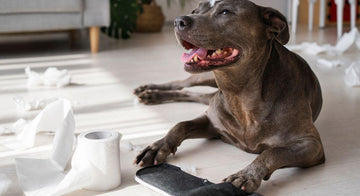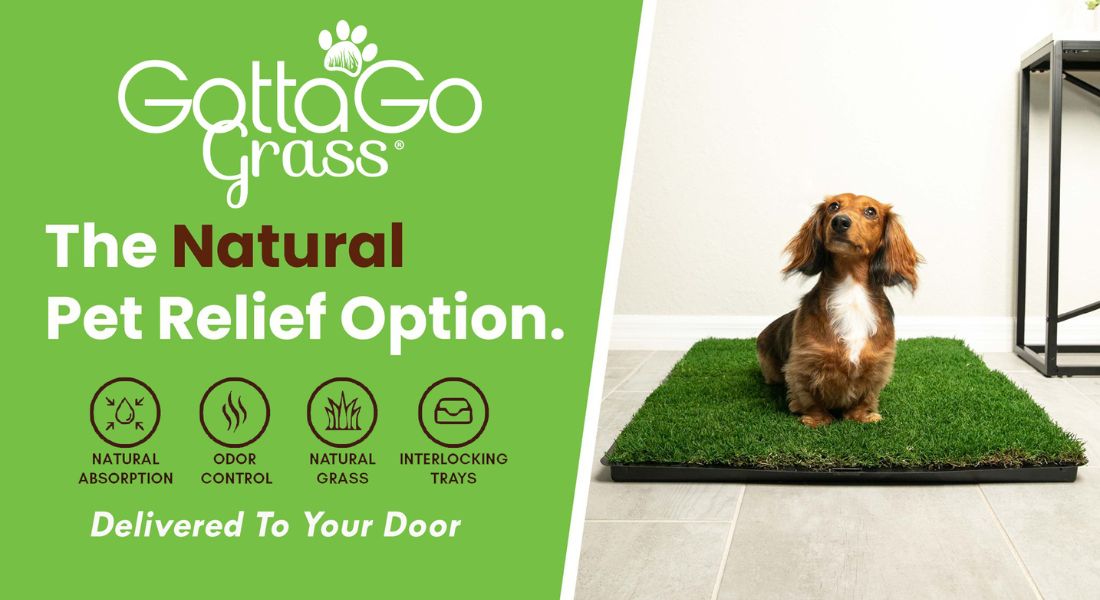
Ever wonder why your dog suddenly tucks its tail and avoids eye contact, and you realize it's already peed at your feet? These are common signs of a behavioral condition called submissive urination. In many situations, a dog urinates submissively in response to a perceived threat as a way to communicate submission to people or more dominant dogs.
Submissive urination is common in puppies, but some dogs don't outgrow it. In such cases, you can modify their behavior by taking measures such as identifying the triggers, avoiding them, and using positive reinforcement instead of punishment.
Gotta Go Grass®, a leading provider of grass pee pads for dogs, offers tips on helping a submissive dog overcome inappropriate urination.
What is Submissive Peeing in Dogs?
As social animals, dogs communicate through body language and vocalization. They often react to your facial expressions, gestures, and voice tones, as they do when communicating with other dogs. In some cases, dogs may offer a submissive signal, such as urination, to show deference to a more dominant individual.
Some human behaviors that can be intentionally or unintentionally threatening to dogs include:
- Scolding or physical punishment
- Direct eye contact
- Standing over them
- Loud noises
- Argument between people
Submissive urination is a common reaction in puppies or dogs adjusting to a new environment. It's often seen in dogs that fear people or have a history of rough treatment, particularly rescued dogs, who may be more sensitive to punishment.
READ: How to Travel Easy with an Anxious Dog

Other Possible Reasons for Inappropriate Urination in Dogs
A dog displaying submissive urination behavior typically shows other signs of submission, such as tail-tucking, avoiding direct eye contact, licking the lips, and lying on its back. It's crucial to differentiate this submissive behavior from other possible causes of inappropriate urination, such as excitement or an underlying health issue, as each requires a different approach to treatment.
Excitement Urination
Sometimes, a dog pees inappropriately when it becomes overly excited, such as during playtime, when you return home, or when new guests or dogs arrive. While this behavior is more common in puppies, some adult dogs may also exhibit it. It's important to avoid scolding or punishing your dog, as this can worsen the behavior.
Patience and understanding are crucial when training your dog out of this behavior. Avoid punishment and temporarily modify your routine to minimize excitement triggers and prevent accidents, such as keeping greetings low-key every time you arrive home. If your dog is excited, avoid direct eye contact until calm. As a precaution, take your dog to its grass pee pad for a bathroom break before engaging in exciting activities. With time and maturity, your dog will learn to control its excitement.
Health Problem
In addition to submissive or excitement-based urination issues, various health problems can affect your dog's bathroom habits. Medical causes such as urinary tract infections, bladder stones, or inflammation within the bladder can lead to inappropriate or frequent urination. More serious health issues like kidney disease, diabetes, or nerve damage, as well as physical injuries or separation anxiety, can also contribute to these problems. Older dogs are also more at risk of urinary incontinence, which causes them to leak or pee without knowing.
In these cases, an indoor grass pee pad for dogs can be useful, providing a designated area for your dog to relieve itself without the stress of having to go outside for a potty break while also reducing the risks of house soiling.
Urine Marking
Male dogs may also engage in marking behavior, which involves intentionally peeing on things to mark their territory. While this is a normal behavior, it's best kept outdoors. If marking persists indoors, consult your veterinarian to address the behavior and rule out any underlying medical issues.

How to Stop Submissive Urination
While most dogs grow out of this behavior, others may need help.
Take your dog to the vet: Before addressing submissive urination, consult your vet to rule out any underlying health issues. A urinalysis can reveal common problems, such as infections. Your vet may also recommend other diagnostic tests, such as x-rays, ultrasounds, or blood work, to check for any other possible issues.
Identify triggers: Be mindful of situations that trigger submissive urination in your dog and try to avoid them. For instance, if your dog gets nervous around strangers, ask your guests to keep their distance and greet your dog with a wave or a smile instead of approaching it directly.
Avoid aggressive or dominant gestures: Speak to your dog calmly, avoid direct eye contact, and pet them under the chin instead of on top of the head. Additionally, approach your dog by kneeling at their level instead of leaning over them, and approach from the side rather than head-on. These actions can help your dog feel more comfortable and less likely to exhibit submissive urination.
Use positive reinforcement: Instead of scolding or punishing your dog for submissive urination, guide it towards good behavior. Teaching it to sit calmly is a good start. Praise and reward your pet immediately when it exhibits confident behavior, such as greeting someone without urinating.
Build your dog's confidence: A more confident dog is less likely to urinate submissively. Engage your dog in regular obedience training and agility exercises to help it feel more in control and confident. Provide your furry friend opportunities to socialize with other dogs and people and offer mental stimulation through interactive toys and puzzles like a treat tumbler.

Reinforce Potty Training Habits with Gotta Go Grass®
Consistent and positive reinforcement during potty training helps dogs learn appropriate bathroom behavior and builds their confidence. When dogs are confident in their understanding of where and when to relieve themselves, they are less likely to exhibit submissive urination as a response to anxiety or uncertainty.
Whereas a waste bag allows you to clean up after your dog if accidents occur, using grass pads for dogs provide a convenient indoor bathroom alternative that replicates the sensory experience dogs associate with the outdoors, reinforcing potty training habits. Our products are designed to help dog owners teach their pets the proper place to go, reducing the likelihood of submissive urination in dogs.
For a range of dog bathroom solutions and accessories, visit the Gotta Go Grass® website today!




